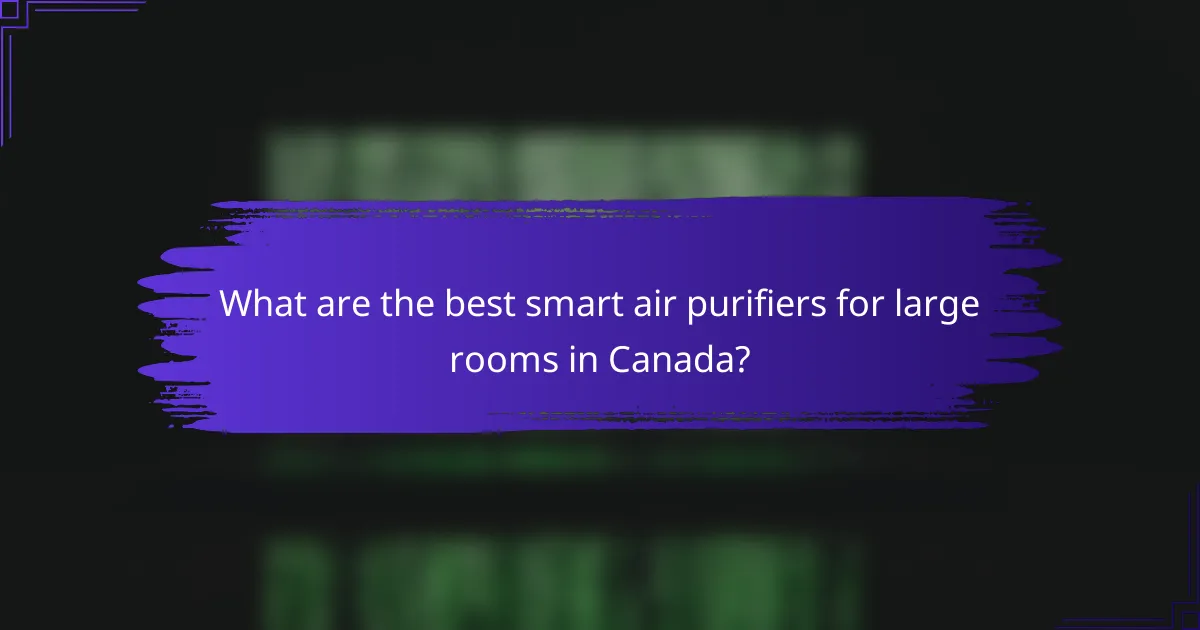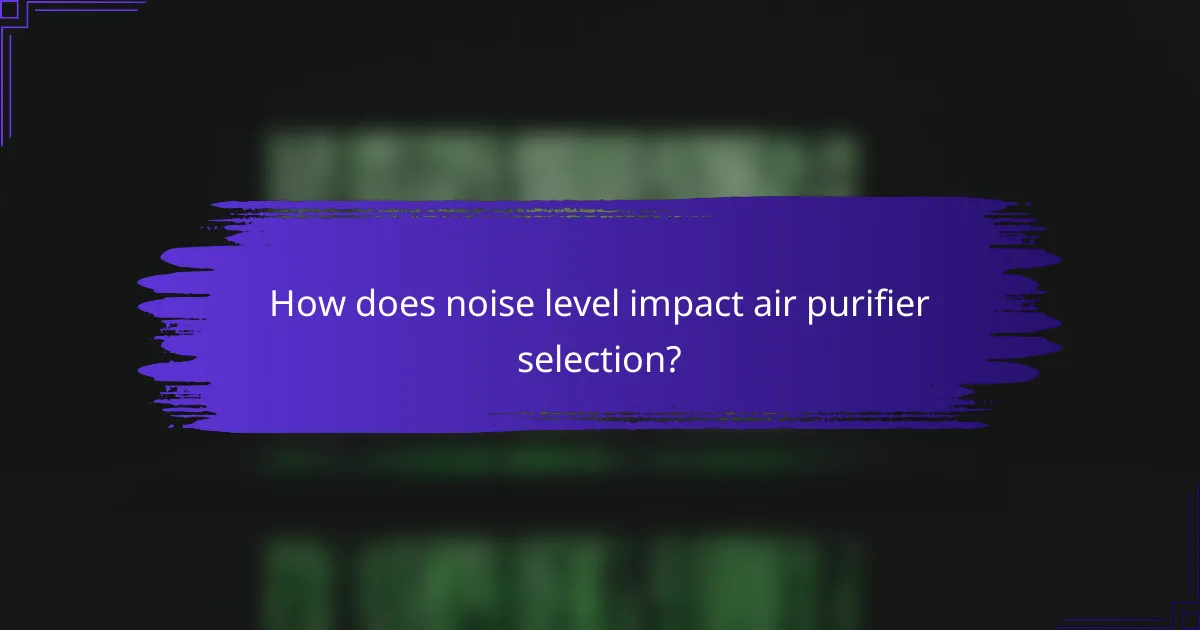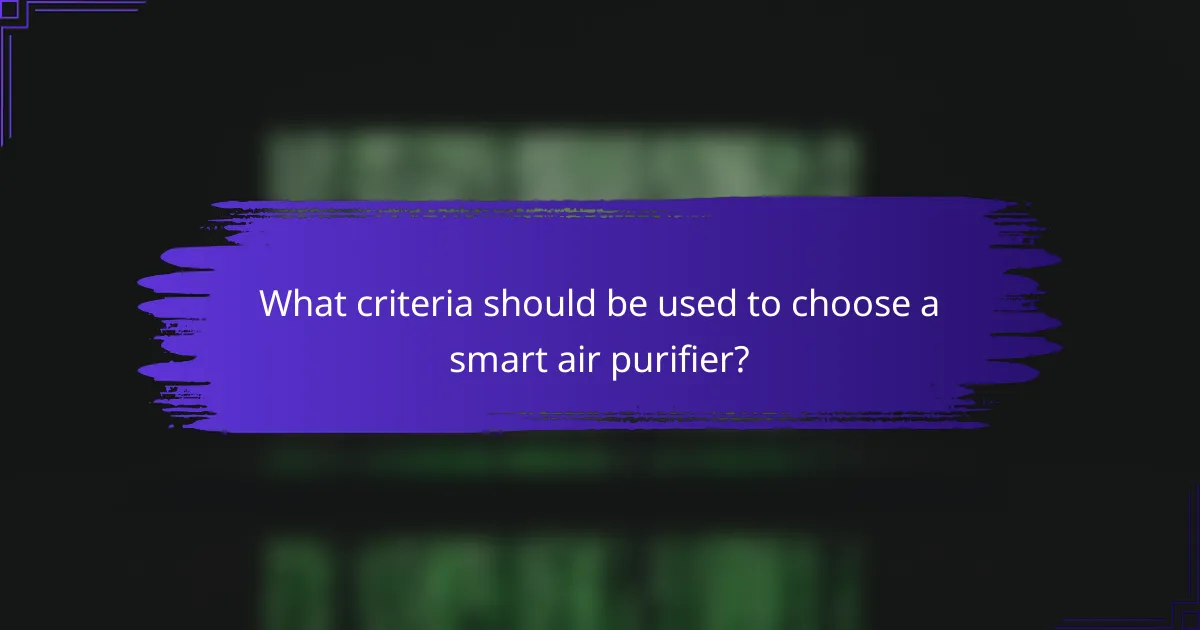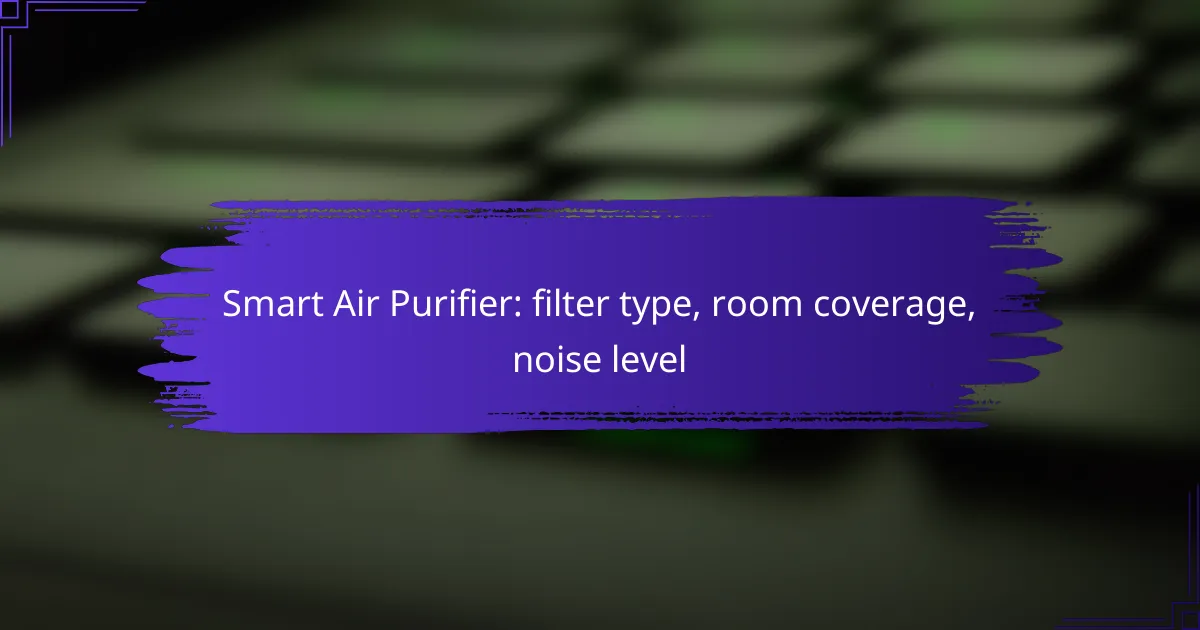Smart air purifiers are essential for maintaining clean air in large rooms, combining effective filtration, extensive coverage, and low noise levels. Understanding the different filter types is crucial for selecting a model that meets your specific needs, whether for allergens, odors, or overall air quality. With ideal room coverage ranging from 300 to 1,000 square feet, choosing the right purifier ensures optimal air cleaning in your space.

What are the best smart air purifiers for large rooms in Canada?
The best smart air purifiers for large rooms in Canada typically combine effective filtration, extensive coverage, and low noise levels. Models like the Dyson Pure Cool TP01, Honeywell HPA300, and Levoit Core 400S stand out for their performance and user-friendly features.
Dyson Pure Cool TP01
The Dyson Pure Cool TP01 is a versatile air purifier that doubles as a fan, making it suitable for large spaces. It features a HEPA filter that captures 99.97% of allergens and pollutants, ensuring cleaner air quality.
This model is designed to cover rooms up to approximately 800 square feet, making it ideal for open-concept living areas. Its quiet operation, with noise levels around 40 dB, allows for comfortable use even during nighttime.
Honeywell HPA300
The Honeywell HPA300 is known for its powerful filtration capabilities, utilizing a true HEPA filter to trap a wide range of airborne particles. This model is effective in rooms up to 1,000 square feet, making it one of the best options for larger spaces.
With three cleaning levels, including a turbo mode for quick purification, the HPA300 operates at a noise level of about 50 dB. This makes it a solid choice for both day and night use, though it may be slightly louder on the highest setting.
Levoit Core 400S
The Levoit Core 400S is a smart air purifier that offers both efficiency and convenience. It features a three-stage filtration system, including a HEPA filter, and is capable of covering areas up to 1,000 square feet.
This model operates quietly, with noise levels around 25 dB, making it suitable for bedrooms or quiet spaces. Its smart capabilities allow for remote control via a mobile app, enabling users to monitor air quality and adjust settings easily.

How do filter types affect air purification?
Filter types significantly impact the effectiveness of air purifiers by determining what particles and pollutants can be captured. Understanding these filters helps consumers choose the right air purifier for their specific needs, such as allergens, odors, or general air quality improvement.
HEPA filters capture 99.97% of particles
HEPA (High-Efficiency Particulate Air) filters are designed to trap at least 99.97% of particles that are 0.3 microns in size. This includes dust, pollen, pet dander, and even some bacteria and viruses, making them ideal for allergy sufferers and those with respiratory issues.
When selecting an air purifier with a HEPA filter, consider the room size and the filter’s Clean Air Delivery Rate (CADR). A higher CADR indicates faster air purification, which is essential for larger spaces. Regular maintenance, such as changing the filter every 6-12 months, ensures optimal performance.
Activated carbon filters reduce odors
Activated carbon filters are effective at absorbing odors and volatile organic compounds (VOCs) from the air. They work through adsorption, where pollutants adhere to the surface of the carbon material, making them particularly useful in kitchens, bathrooms, and areas with pets.
To maximize the effectiveness of activated carbon filters, look for models that combine them with HEPA filters for comprehensive air purification. Keep in mind that these filters may need to be replaced every 3-6 months, depending on usage and environmental factors, to maintain their odor-reducing capabilities.

What is the ideal room coverage for smart air purifiers?
The ideal room coverage for smart air purifiers typically ranges from 300 to 1,000 square feet, depending on the model and its intended use. Choosing a purifier with appropriate coverage ensures effective air cleaning in your space.
Coverage area of 500 square feet
A smart air purifier with a coverage area of 500 square feet is suitable for medium-sized rooms. This size allows for efficient air filtration in spaces like offices, dining areas, or larger bedrooms. When selecting a purifier, check the Clean Air Delivery Rate (CADR) to ensure it can handle the air volume in your room.
For optimal performance, consider purifiers that can cover slightly more than your room size, as this allows for better air circulation and filtration efficiency. A unit rated for 600 square feet would be ideal for a 500 square foot room.
Optimal for living rooms and bedrooms
Smart air purifiers with a coverage of 500 square feet are particularly effective in living rooms and bedrooms, where air quality can significantly impact comfort and health. In living rooms, they help reduce allergens and pollutants from activities like cooking and entertaining.
In bedrooms, these purifiers can enhance sleep quality by filtering out dust, pet dander, and other irritants. Placing the unit near the bed or in a corner can maximize its effectiveness, ensuring cleaner air throughout the space.

How does noise level impact air purifier selection?
The noise level of an air purifier is crucial for ensuring comfort, especially in quiet environments like bedrooms or offices. Selecting a model with an appropriate noise level can enhance your experience, allowing for uninterrupted sleep or concentration.
Quiet operation under 30 dB
Air purifiers that operate under 30 dB are considered very quiet, making them ideal for use in bedrooms or study areas. At this noise level, the sound is comparable to a whisper, allowing for a peaceful atmosphere while still effectively cleaning the air.
When choosing a quiet air purifier, look for models specifically designed to minimize noise. Many manufacturers provide decibel ratings, so check these specifications to ensure the unit meets your needs for silence.
Sleep mode features for nighttime use
Many modern air purifiers come equipped with a sleep mode that reduces both noise and fan speed during nighttime hours. This feature ensures that the purifier operates quietly while still maintaining air quality, making it suitable for light sleepers.
When selecting an air purifier, consider those with adjustable sleep modes that automatically adjust settings based on the time of day. This can enhance your comfort by providing cleaner air without disruptive noise while you rest.

What criteria should be used to choose a smart air purifier?
When selecting a smart air purifier, consider the filter type, room coverage, and noise level. These factors significantly impact the device’s effectiveness, usability, and suitability for your living space.
Filter type and efficiency ratings
The filter type is crucial for determining how well an air purifier removes pollutants. HEPA filters are highly recommended as they can capture particles as small as 0.3 microns, including dust, pollen, and pet dander. Look for models with efficiency ratings such as CADR (Clean Air Delivery Rate) to gauge their performance in removing specific contaminants.
Additionally, some purifiers come with activated carbon filters that help eliminate odors and volatile organic compounds (VOCs). When comparing models, check for certifications like AHAM or ENERGY STAR, which indicate adherence to performance standards and energy efficiency.
Room size compatibility
Room size compatibility is essential for ensuring that the air purifier can effectively clean the air in your space. Most manufacturers provide a recommended square footage for each model, which helps you choose one that fits your room size. For optimal performance, select a purifier rated for a room size slightly larger than your actual space.
For example, if your room is around 200 square feet, consider a purifier designed for 250-300 square feet. This extra capacity allows for better air circulation and filtration, especially in high-traffic areas or rooms with pets. Always check the specifications before purchasing to avoid underperformance.

What are the costs associated with smart air purifiers in Canada?
Smart air purifiers in Canada typically range from moderate to high costs, depending on features and specifications. Consumers should consider both the initial purchase price and ongoing maintenance expenses, such as filter replacements, when budgeting for these devices.
Price range from $150 to $800
The price of smart air purifiers in Canada generally falls between $150 and $800. Lower-end models may offer basic filtration and smart features, while higher-end options often include advanced technologies, larger coverage areas, and additional functionalities like air quality monitoring.
When selecting a model, consider your specific needs, such as room size and desired features. Investing in a more expensive unit may provide better performance and longer-lasting benefits, especially in larger spaces or for those with allergies.
Long-term filter replacement costs
Filter replacement costs for smart air purifiers can vary significantly, typically ranging from $20 to $100 per filter, depending on the type and brand. Most filters need to be replaced every 6 to 12 months, so it’s essential to factor these costs into your overall budget.
To minimize expenses, look for models that use washable or reusable filters. Additionally, some brands offer subscription services for filter replacements, which can help ensure you always have a fresh filter on hand while potentially saving money in the long run.
